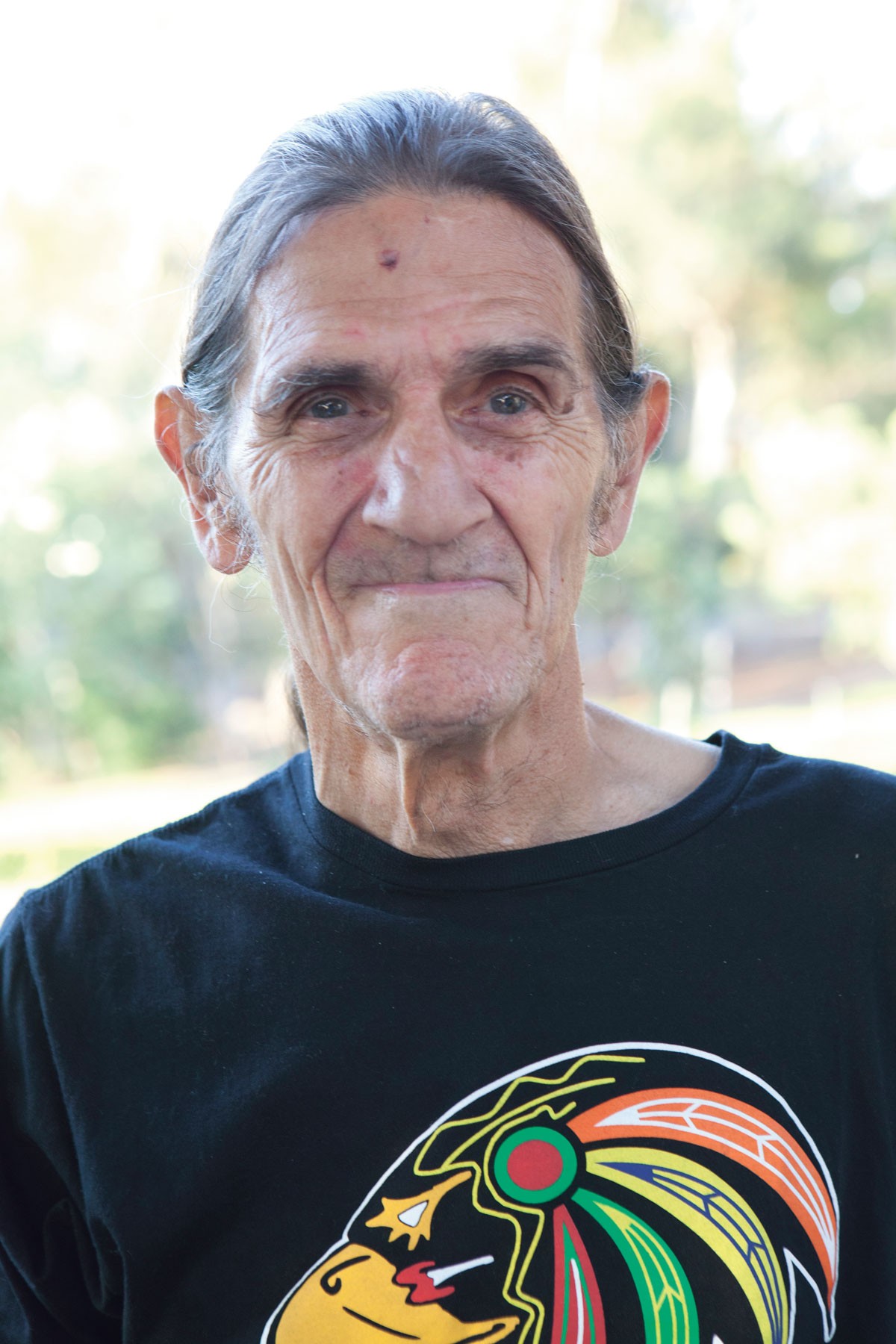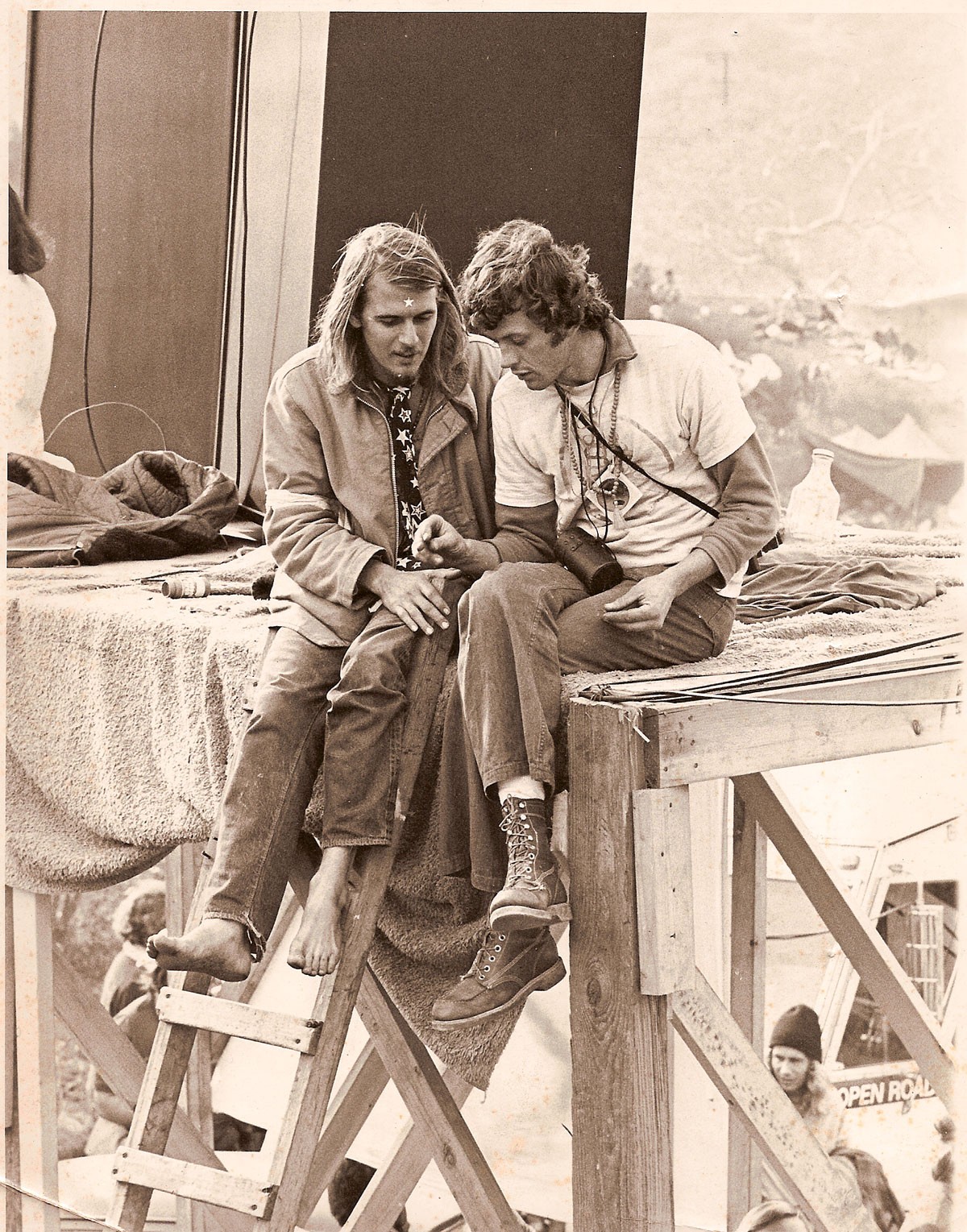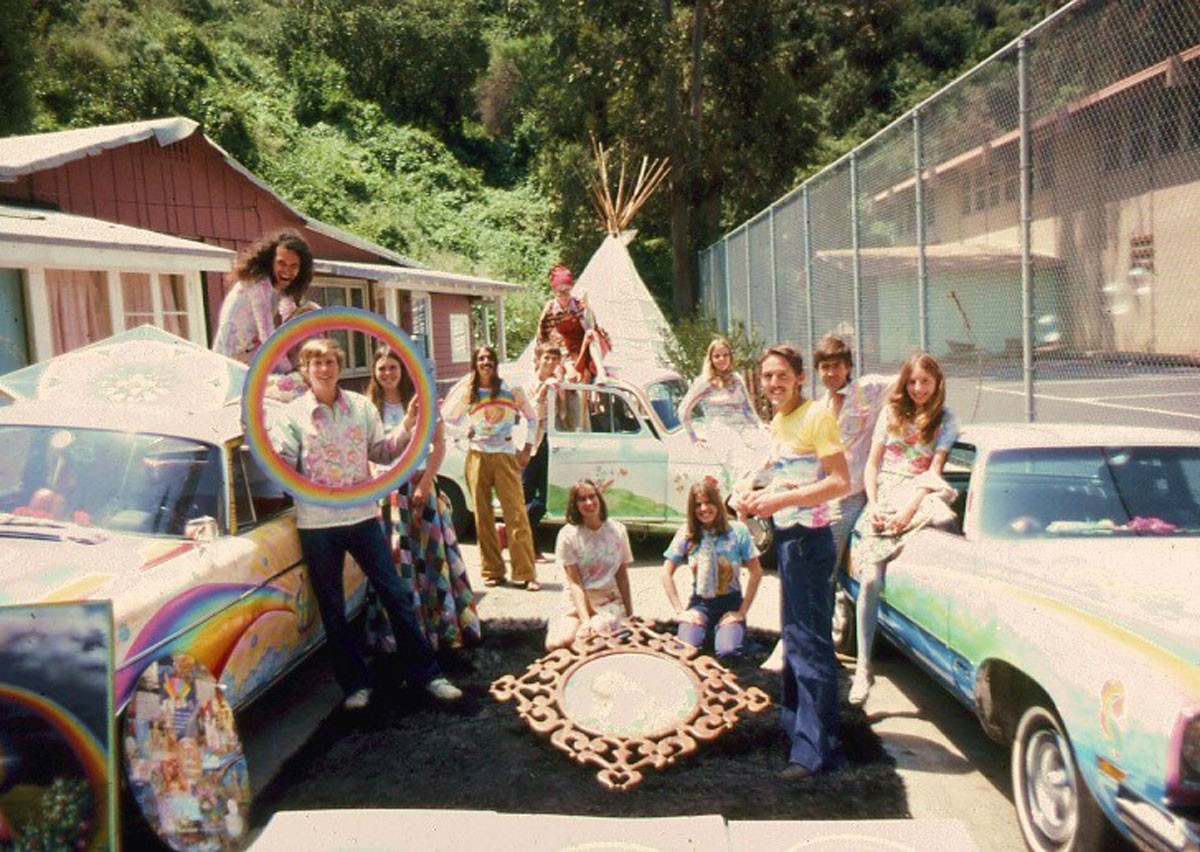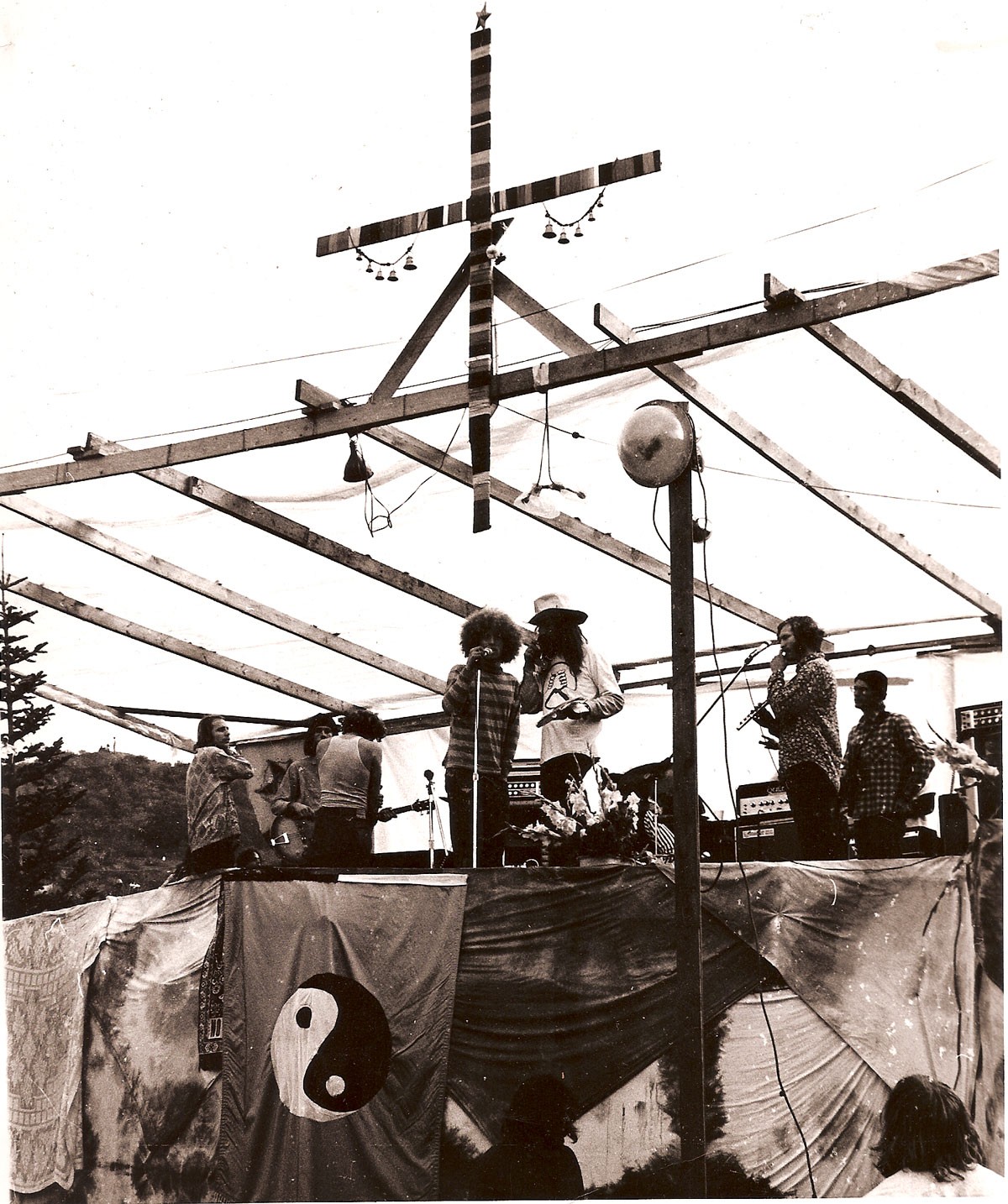
The man who organized the largest spontaneous rock concert in the history of Orange County lives in a van in a parking lot at Huntington Beach Central Park.
Curtis Rainbow, 69, who changed his last name from Reed 40 years ago, shares the cramped vehicle with his 48-year-old girlfriend, Melissa McKinney. The pair met just more than two years ago, when Rainbow was sharing his car with a white miniature poodle named Daisy, who disappeared one evening from the busy parking lot where he was parked. After three days of frantic searching, Rainbow was about to give up his search when he asked a woman who happened to be walking by if she had seen Daisy. The woman was McKinney, who helped Rainbow search for the dog. They never found the dog, but they have been together ever since.
Despite being homeless, Rainbow has a cell phone, regular access to electricity and an active Facebook account, which is how he contacted me a few months ago. Although I had never spoken to Rainbow, I’d known about him since researching my 2010 book, Orange Sunshine: The Brotherhood of Eternal Love and Its Quest to Spread Peace, Love, and Acid to the World. According to several people I interviewed, Rainbow was the person responsible for the Christmas Happening, a four-day rock festival that began on Dec. 25, 1970, and saw some 25,000 flower children from all over the country descend on Laguna Beach.
The outdoor concert at the top of Laguna Canyon is the most storied cultural event in Laguna Beach. But Rainbow’s importance to Orange County’s countercultural history didn’t begin or end there. In the mid-1960s, Rainbow opened Laguna’s first head shop, Things, and followed that in 1972 with a legendary vegetarian restaurant called Love Animals, Don’t Eat Them. He even founded a hippie commune called Rainbow Island, which operated a nonprofit church and sustained itself by painting psychedelic shirts that were widely distributed at rock concerts and art festivals throughout Southern California and beyond.
I had tried to interview Rainbow for my book, but my sources always said he was unavailable. Without going into details, they told me that trying to talk to him would be a waste of time. From the sound of it, things were even worse for him now than when I first learned his name. But when I met Rainbow, I realized his faculties of memory and perception were still quite intact. He was ready to talk, and I was curious to hear his story.
* * * * *

Rainbow and McKinney are waiting for me in front of the Huntington Beach Public Library on a recent weekday morning. A few hours earlier, a squad of police officers had rousted them from their nearby tent. We walk to the abandoned, well-shaded campsite on the soft, sloping bank of a duck pond. A squirrel sitting on a log twitches its tail, suspiciously eyeing a packing crate, the last remnant of Rainbow’s abandoned campsite. “He’s a big one,” McKinney says, pointing at the rodent. “He wants to get in the box, Curtis.”
Rainbow says the police were polite, even friendly, when they told him to pack up the tent. “They were part of a tactical squad, and their mission is to help the homeless with resources, give them information,” he says. “They didn’t even ask for my ID. No threat, just telling me the rules in the park. Not bad, huh?”
We trek around the pond to a path that takes us past the so-called “Secret Garden,” a fenced-in, drought-friendly garden planted by local volunteers. “Isn’t this beautiful?” Rainbow asks. “You’d never know you were in Orange County.”
As we pass through an area of natural vegetation, Rainbow remarks that there are 16 acres of original chaparral inside the park. “Do you know how big 16 acres is?” he asks. “I do,” he continues, “because I spent five years in a place called Rainbow Ranch in Warner Hot Springs, where we had 17 acres in the desert.”
Eventually, we reach Kathy May’s Lakeview Cafe, which, as the name suggests, offers a nice view of a small lake. Over the next three hours, Rainbow sparingly picks at a small bowl of fruit while recounting his life story. Rainbow experienced a peripatetic upbringing in the 1950s as the son of a design engineer who supervised a team of engineers working in NASA’s orbital technology program. Although his father was secretive about his work and was always flying off to some military base or another, he still took time to teach Rainbow about science, helping him learn basic electronics and obtain an amateur radio license.
An apt pupil, Rainbow left high school two years early and qualified for classes at Orange Coast College. By the time he was 19 years old, Rainbow was selling fabric to clothing manufacturers in Los Angeles’ garment district, making $60,000 per year—an unheard-of salary for a teenager in the early 1960s. “This was about the time pot started coming around,” says Rainbow, “and eventually, the acid came.” Before dropping LSD, Rainbow prepared himself by reading literature about the drug by psychedelic scholars such as Timothy Leary, the defrocked Harvard professor and acid promoter who, shortly before the U.S. government banned acid, officially ushered in the hippie era by coining the phrase “Turn on, tune in, and drop out.”

Taking acid changed Rainbow’s life. He quit his job and moved to Laguna Beach to establish Things at 761 S. Coast Hwy. At the end of the summer of 1967, Timothy and Rosemary Leary moved into a hotel room next door to Rainbow’s shop. The couple eventually settled in town, and Rainbow roomed with Leary’s daughter Susan in the Happy House. At the time, Leary was fighting a federal marijuana case stemming from an arrest at the Texas-Mexican border, and Rainbow became Leary’s chauffeur to the courthouse. He recalls driving Leary in a purple Cadillac and being greeted by a swarm of television reporters. “My parents called me from Garden Grove to say they saw me on TV,” he says, laughing.
Following Leary to Laguna Beach was police officer Neil Purcell, who made it his mission to arrest as many drug suspects as possible, a long list of busts that eventually included Leary. Because of his long hair, Rainbow says, he immediately became a target of Purcell’s anti-narcotics patrols, which typically focused on the Taco Bell restaurant downtown on Pacific Coast Highway, which kids from all over Orange County knew as a good spot to score acid. “On his first day, right behind Taco Bell, [Purcell] singled me out,” Rainbow says. “He got me in the back of his car.” While a crowd gathered, Purcell grilled Rainbow about drug use in the city. When Rainbow feigned ignorance, Purcell finally let him go. “Everyone said, ‘What did he want?’ And I said, ‘I don’t know, but he really is scared of me.”’
On Dec. 26, 1968, Rainbow was hanging out at the Happy House when Timothy and Rosemary stopped by with Leary’s daughter, Susan, and son, Jack, on their way to Laguna Canyon. Thirty minutes after the family left, Rainbow received a phone call that Purcell had just busted Leary for marijuana possession. (Leary would wind up in prison for the crime, only to be busted out and smuggled to Canada and eventually Afghanistan before being re-arrested and flown back to California.)
A year later, Purcell and other officers raided Rainbow’s neighbor’s house. Panicking, Rainbow dashed out of his house to hide a kilogram of marijuana under his car. The next morning, Purcell knocked on Rainbow’s door to let him know he had seen him hiding the pot. Although Purcell confiscated the marijuana, he didn’t arrest Rainbow. Knowing that he could spend five years in prison if Purcell changed his mind, Rainbow left California.
He spent the next 12 months crashing in a cabin with a rock band in Florida, dealing Orange Sunshine acid, hitchhiking through Canada and camping in the woods. When he finally returned to Laguna Beach, Purcell spotted him on the street and confronted him about his fugitive status. But to Rainbow’s surprise, Purcell didn’t arrest him, and he never mentioned the matter again. “Everybody has their good side,” Rainbow says of Purcell. “I think if you are going to point out their badness, you have to point out their little bit of goodness.”
After returning to Laguna Beach, Rainbow spent his days panhandling, wandering the streets barefoot, his clothing tattered from his travels. Any cash that came his way paid for handbills with names such as the Weekly Dose and the Daily Tab, messages of peace and love that Rainbow would pass out, 5,000 or 10,000 copies at a time. One day in 1970, Rainbow came up with the idea of advertising a concert with his fliers. “Let’s have a get-together on Christmas Day,” he thought to himself. “Wouldn’t that be fun? Everybody can put a van in their front yard. We’ll get the whole town to have Christmas together.”
Rainbow approached a local psychedelic artist named Bill Ogden and asked him to design a poster for the event. He also recruited another artist, Dion Wright, who recalls being horrified at Rainbow’s plan to hold the concert on Main Beach near the downtown shopping district. “He told me about his concept and collared me into it,” Wright says. “He got the idea for the Christmas festival not out of any idealism, but like an ape tinkering with a bomb. He thought it would be fun to unleash anarchy on Main Beach.”
At Wright’s insistence, Rainbow agreed to market the concert in a more spiritual manner—as a birthday party for Jesus—and, perhaps more important, to relocate it in a more suitably remote area near the top of Laguna Canyon. Helping Rainbow to promote the event and find artists to perform was his friend Ted Shields, a talented airbrush artist nicknamed “Star” who had worked at the Oracle in LA. Based on his connection with the newspaper, Shields secured free advertising for the festival while Rainbow managed to convince the L.A. Free Press to dedicate eight pages to the upcoming event.
“We had two or three weeks to work on it, and what we did was start spreading rumors—some were actually founded on fact,” Shields recalls, adding that the only prominent rock band that they claimed was going to perform who even remotely considered it was the Grateful Dead, who backed off after their stage crew was turned back by police roadblocks. “We didn’t really call bands up; we just told people to come,” Shields says. “We wanted to get a big crowd, a mob. It wasn’t really an organized rock festival.”
Meanwhile, hundreds if not thousands of invitation cards—each of which contained a tab of Orange Sunshine acid—went out to the public via the hippie underground. The hype worked, and the crowds came—and kept coming. By Christmas Day, some 25,000 hippies, some of them camping in vans, some in tents, some wrapped in blankets to protect them from the early winter chill, had gathered around the wooden stage.
Much has been written about the festival over the years, but the definitive retrospective was written for the OC Weekly by Bob Emmers (see “Laguna On Acid,” Dec. 24, 1998). Suffice it to say that the festival is recalled less for the music than for the almost unfathomable freakery in an Orange County that had just sent local hero Richard Nixon to the White House. Led by the omnipresent Purcell, a multi-agency police task force cordoned off the concert site and confiscated untold quantities of drugs from concertgoers. At some point during the show, however, a Cessna flew overhead, its pilot determined to breach the barricades and give new meaning to the phrase “dropping acid.” The plane released an entire load of LSD-laced invitation cards on the crowd.
* * * * *

Looking back across the decades, it’s clear the Christmas Happening was the defining moment in Rainbow’s life, an apex that symbolized the end of the hippie era in Orange County history. But Rainbow was determined to keep the faith alive as long as possible. On July 4, 1972, he opened a vegetarian restaurant called Love Animals, Don’t Eat Them (LADET), which was shut down on its opening day over a code violation involving a live camel on the premises. “We said idealistically that we wouldn’t charge anybody for anything,” Rainbow says. “It was totally organic, vegan, the best food you could get, and of course, donations only.”
City health inspectors seemed intent on putting LADET out of business. It didn’t help that Rainbow refused to allow them inside the kitchen if they were wearing leather. “We made the health inspector take his shoes and belt off to walk in our kitchen,” Rainbow says. After one too many code violations, LADET permanently closed its doors. Rainbow then teamed up with his artist friend Shields, who had created an art collective called the Rainbow Kids. Along with his two female cohorts, Luna and Nebula Rainbow, Shields was airbrushing psychedelic shirts for rock artists such as Led Zeppelin, George Harrison, Donovan and Paul McCartney. A born salesman, Rainbow not only helped market the shirts, but also convinced Shields to help him parlay the venture into a nonprofit church, a last-gasp Laguna Beach hippie commune called Rainbow Island.
The main building where commune members lived, worked and ran a small kitchen was called Rainbow House, and according to Bitsy Mason, one of the former members, Rainbow spent countless hours in a cabin behind Rainbow House, researching the law and writing up the church’s articles of incorporation. “I thought he was brilliant,” Mason says. “He put together the whole incorporation. It was a lot of work.”
Soon, the group had a sales manager who helped to set up deals with various retailers, and Mason was producing up to $800 worth of merchandise per day. “It was a great time,” she recalls.
Mason met Rainbow shortly before the Christmas Happening, when she was only 16. She says Rainbow gave her her first tablet of Orange Sunshine LSD. “He explained the oneness of life,” Mason says. “I became a vegetarian for the rest of my life that night.” But by the time Mason was living with Rainbow at the Rainbow House, she says, his experimentation with psychedelics had all but isolated him from the group’s other members. “Nobody saw him for a while,” she says. “He was flying high and didn’t come back to earth until a year and a half later.”
Mason also recalls Rainbow exhibiting signs of depression. “He wouldn’t talk to anybody,” she says. Mostly, Rainbow seemed unable to grasp why his utopian visions weren’t catching on with more people. “He just didn’t understand. He was so far out there.” (Rainbow denies he was depressed or bitter that his efforts to bring peace and love to the world weren’t more successful. “I just moved on,” he says).
According to Mason, Rainbow’s pharmacological obsession “wasn’t just escapism,” but a genuine attempt to understand the universe. “He paid a high price with those drugs,” she says. “He was trying to find the cosmic matrix. He was looking and looking for the essence of the cosmos.”
While Rainbow was busy exploring the outer reaches of his mind, Shields had managed to convince a wealthy donor to give the Rainbow House $120,000 in startup funds. “The rest is a [history] of crazy hippies not knowing how to manage money,” Shields says. A big part of the problem, according to Shields, is that once the Rainbow House became a nonprofit, Rainbow declared that only members of the church could buy shirts.
In Rainbow’s mind, because the church had 100,000 members, all of whom were signed up at rock concerts, that shouldn’t have been a problem. “Before that, we had a sales rep, and we were selling $3,000 or $4,000 worth of shirts a week,” Shields explains. “But it turned off a lot of retailers that you couldn’t buy a shirt without being a member, and none of us had the marketing ability to keep it going.”
According to Shields, Rainbow somewhat singlehandedly doomed Rainbow Island. “He had the idea and the vision, but not the integrity to carry it out,” he says. “In some ways, we were all to blame.”
* * * * *

On April 14, Purcell, who now lives in Montana, returned to Orange County to talk about the Christmas Happening for an event at the Laguna Beach Historical Society. At the end of Purcell’s speech, Rainbow shook the ex-cop’s hand and, without mentioning the time Purcell almost busted him for marijuana, thanked him. As the pair smiled for photographs, Rainbow made a peace sign for the camera.
Despite the happy reunion with Purcell, Rainbow is estranged from almost everyone in his life who might be able to help him.
After Rainbow Island fell apart in the mid-1970s, Rainbow spent five years in an inhospitable desert valley near Warner Hot Springs, growing marijuana on a commune called Rainbow Ranch. When that project inevitably fizzled, Rainbow turned his attention to the anti-nuclear and peace movements. He befriended numerous rock stars, at least in his own mind. By the end of the decade, Rainbow had become a heavy user of ketamine. (Rainbow says he was using ketamine as therapy after a car crash and that he stopped using it in 2001. He no longer uses any psychedelic drugs.) “It’s a very enlightening drug, and I don’t have anything bad to say about it,” Rainbow says. “But I was getting further and further out on it.”
At that time, Rainbow lived at home with his parents. First, his father died, then his mother. When his siblings—a schoolteacher sister in Garden Grove and a pair of brothers in Idaho and Arizona—wanted to sell the house, Rainbow ended up on the streets with nothing but a pair of cars and his mom’s poodle, Daisy, which is how he met McKinney.
Rainbow inherited a sizable amount of money, so after a few months on the streets, the couple scored a cozy spot in an industrial storage unit in Huntington Beach.
But by the time their landlord evicted them earlier this year, Rainbow was almost broke, so they moved across Goldenwest Street to Huntington Beach Central Park. Rainbow says he sunk tens of thousands of dollars into the rental space and that the landlord unfairly threw him out on the streets just when he and McKinney were about to launch a book-selling business, which they now can’t operate because they had to put the books in storage—and without the business, they have no way to avoid being homeless.
The couple also lost a pair of bicycles during the move and set up a modest GoFundMe account (www.gofundme.com/6zzmmdx8) in the hopes of receiving enough donations to replace them. (Thanks to a small donation, he was able to replace the bicycles.)
“Curtis burned bridges with everyone involved in Rainbow Island,” Shields claims. Still a successful airbrush artist, Shields recently began republishing the long-defunct Oracle newspaper. He’s done two issues so far and is currently seeking funds for a third. “I’m really grateful I didn’t turn out like him. . . . I did the drugs, too—probably too many—but I’m happy to say I’m over it.”
“He’s a charming rogue, and his best talent is as a salesman,” adds Wright, who in March published a memoir of Laguna Beach in the 1960s, Tempus Fugitive. “But his worst failing is his susceptibility to chemicals.”
Mason says that she will always be grateful for the role Rainbow played in turning on her and so many others of her generation. “Curtis was such a visionary,” she argues. “His whole purpose was to remind people that there is far more to this life than the mundane, and all it takes is for us to look up and look around and connect with one another. Unfortunately, he did pay for that with his nervous system.”
Now a real-estate broker in San Diego, Mason hasn’t spoken to Rainbow for 25 years. “I feel bad about where he has ended up, but there is nothing I can do for him,” she says. “I survived, and unfortunately, he went off the deep end. But to this day, I thank him for showing me the things he showed me.”
Rainbow’s small van is stuffed with bags of clothes, some of which he has obtained for free from a local charity. The rest of his belongings, including his library of 10,000 first-print hardcover books, are being held in a storage locker whose owner won’t allow Rainbow to access them until he pays his overdue rent on the space. After interviewing Rainbow, I drive him by the locker, and when Rainbow spots the owner, a burly man in a polo shirt and shorts, he rolls down the window. “I’ll have some money for you on the first of the month,” he yells.
Upon recognizing Rainbow, the man frowns. “That’s what I keep hearing,” he replies gruffly, and we drive on.


I lived in the same 8’ by 10’ cabin behind the rainbow house in ‘74:’75 and learned to airbrush tshirts from Mick,Michael Rainbow,Pistachio.Also met Ted, Summer, Star and many others.When Rainbow Island split up I became the rent collector for Paul Westbrook who also owned the Rainbow Ranch which Pistachio showed me. I still have an original Rainbow Island postcard.There is much more to tell about this truly magical place and time.
Wow, awesome blog structure! How lengthy have you been blogging for?
you made running a blog look easy. The whole glance of your site is
excellent, let alone the content material! You can see similar here e-commerce